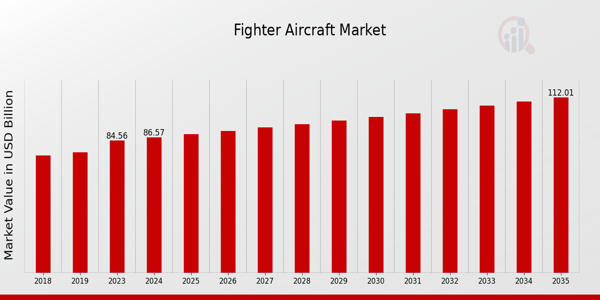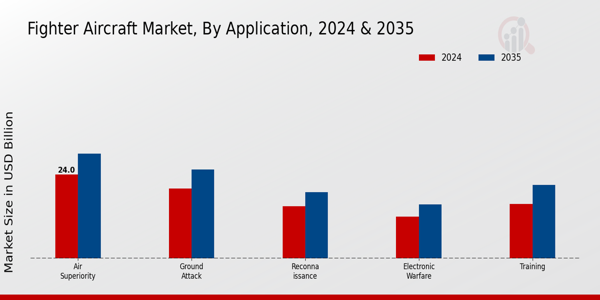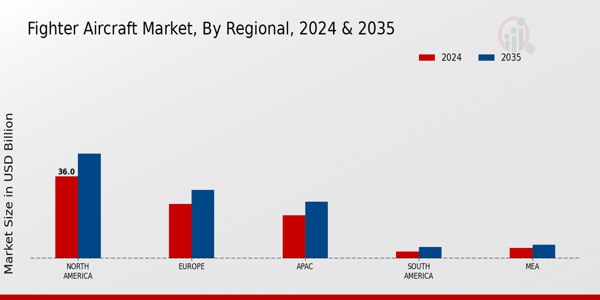Fighter Aircraft Market Overview
The Fighter Aircraft Market Size was estimated at 84.56 (USD Billion) in 2023.The Fighter Aircraft Market is expected to grow from 86.57(USD Billion) in 2024 to 112.0 (USD Billion) by 2035. The Fighter Aircraft Market CAGR (growth rate) is expected to be around 2.37% during the forecast period (2025 - 2035).
Key Fighter Aircraft Market Trends Highlighted
A number of important market factors are causing a major transformation in the global defense industry. Nations are prioritizing military modernization and investment in cutting-edge technologies as a result of rising geopolitical tensions and ongoing conflicts.
As cybersecurity risks have increased, governments are strengthening their defenses to safeguard vital assets and infrastructure. Additionally, the use of unmanned systems and the emergence of asymmetric warfare are changing defense tactics, necessitating innovation and flexibility in the industry.
Opportunities are abundant in areas such as artificial intelligence, cyber defense, and advanced manufacturing. Opportunities in the market can be further explored through increased collaboration between government and private sectors. Partnerships in research and development can lead to innovations that address specific military needs.
Countries looking to enhance their defense capabilities are also seeking to engage in offset agreements, which can facilitate technology transfers and local manufacturing.
Additionally, the trend toward multirole fighter aircraft provides an avenue for flexibility and adaptability in various combat scenarios, allowing defense forces to maximize their operational effectiveness without substantial investments in different platforms.
Recent trends indicate a shift toward more versatile and multi-capable fighter aircraft. The integration of advanced technologies is evident as nations prioritize platforms that can perform multiple roles. The emphasis on network-centric warfare is also changing how fighter aircraft are designed and operated.
Enhanced connectivity and interoperability with other military assets are becoming crucial for success in modern conflicts. Furthermore, ongoing discussions surrounding sustainability and green technologies are influencing the next generation of fighter aircraft, pushing for solutions that reduce environmental impact while maintaining operational superiority.

Source: Primary Research, Secondary Research, MRFR Database and Analyst Review
Fighter Aircraft Market Drivers
Increasing Defense Budgets
The Global Fighter Aircraft Market is witnessing a significant expansion driven by the increasing defense budgets of various countries around the world. As geopolitical tensions escalate and nations prioritize their national security, governments are allocating higher budgets to modernize and expand their military capabilities.
This trend reflects a broader understanding of the importance of maintaining a robust air defense system, leading to increased investments in advanced fighter aircraft. In the face of emerging threats, nations are compelled to enhance their aerial capabilities, which subsequently enhances the demand for cutting-edge fighter jets.
Technological advancements further compel military forces to upgrade their existing fleets, which often leads to substantial procurement of new aircraft. The advancements in avionics, weapons systems, stealth technology, and combat readiness provide military forces with the tools necessary for effective air supremacy.
As countries continue to encounter complex security challenges, the Global Fighter Aircraft Market is likely to grow significantly in response to the urgent need for advanced military hardware, ensuring nations can maintain their air force capabilities for deterrence and defense.
Technological Advancements in Aircraft Design
Technological advancements in aircraft design and manufacturing processes play a crucial role in shaping the Global Fighter Aircraft Market. Innovations such as stealth technology, advanced avionics, and improved materials have significantly enhanced fighter aircraft performance.
These advancements not only improve the efficiency and effectiveness of military operations but also ensure that aircraft are capable of meeting contemporary combat standards.
The emphasis on developing multirole fighter aircraft, which can perform various missions with ease, also aligns with modern military strategies. This diversification of capabilities drives demand as armed forces seek to acquire versatile platforms that can adapt to different operational scenarios.
Rising Geopolitical Tensions
Rising geopolitical tensions in various regions of the world contribute significantly to the growth of the Global Fighter Aircraft Market. The evolving nature of warfare and emerging threats necessitate enhanced military readiness for many nations.
As countries face challenges from hostile neighbors or internal conflicts, there is an increased focus on strengthening air defense systems. Enhanced military engagement and alliances often lead to nations investing in newer, more advanced fighter aircraft as a means of both deterrence and defense.
This drive for national security creates substantial opportunities for market players to supply sophisticated aircraft that can meet the demands of modern warfare.
Fighter Aircraft Market Segment Insights:
Fighter Aircraft Market Application Insights
The Global Fighter Aircraft Market showcased significant potential within its Application segment. This segment can be broadly divided into five key categories: Air Superiority, Ground Attack, Reconnaissance, Electronic Warfare, and Training, each contributing uniquely to market dynamics.
Among these, Air Superiority held the largest market share, valued at 24.0 USD Billion in 2024 and expected to rise to 30.0 USD Billion by 2035, reflecting its crucial role in maintaining aerial dominance and ensuring national security.
The Ground Attack category followed closely, with a valuation of 20.0 USD Billion in 2024 and a projected increase to 25.5 USD Billion in 2035, underscoring its importance in direct combat and support operations.
In terms of market presence, the Reconnaissance segment, with values of 15.0 USD Billion in 2024 and growing to 19.0 USD Billion in 2035, played an essential role in intelligence gathering and surveillance, which are vital for modern warfare strategies.
The Electronic Warfare sub-segment, valued at 12.0 USD Billion in 2024 and anticipated to rise to 15.5 USD Billion by 2035, was integral for countering enemy threats and enhancing communication security, reflecting the technological advancements in warfare capabilities.
Meanwhile, the Training segment, with a valuation of 15.57 USD Billion in 2024 and projected growth to 21.0 USD Billion by 2035, supported the development and proficiency of personnel, which is crucial in the rapidly evolving combat environment.
This segmentation illustrated the diverse applications within the Global Fighter Aircraft Market and highlights how each area not only contributed to market growth but also played a vital role in national defense initiatives, technological progress, and operational efficiency in military operations across the globe.
Market trends indicated a growing emphasis on enhanced capabilities within these applications, driven by advancements in technology, increasing defense budgets, and the need for robust military strategies, presenting both challenges and opportunities in this evolving landscape.
Moreover, the combination of high-value market statistics reinforced the importance of strategic investments in each application to effectively address emerging threats and capitalize on evolving defense needs globally.

Source: Primary Research, Secondary Research, MRFR Database and Analyst Review
Fighter Aircraft Market Type Insights
The market segmentation includes Multirole Fighters, Stealth Fighters, Interceptor Fighters, and Trainer Fighters, each playing a critical role in advancing military capabilities.
Multirole Fighters are significant due to their versatility in various combat scenarios, allowing nations to maximize their defense strategies. Stealth Fighters represent a vital component as they offer advanced technologies that enhance mission success rates while minimizing detection.
Interceptor Fighters are essential for national air defense, ensuring rapid response against potential threats. Trainer Fighters are crucial for preparing the next generation of pilots and maintaining operational efficiency. The dynamics of these types drive the Global Fighter Aircraft Market growth, influenced by technological advancements, geopolitical tensions, and evolving defense strategies.
Understanding Global Fighter Aircraft Market data provides valuable insights into market trends that shape the industry landscape and reveals the intricate interplay of demand across different types, which is essential for stakeholders looking to navigate this competitive environment.
Fighter Aircraft Market Delivery Mode Insights
The Global Fighter Aircraft Market showcases a diverse Delivery Mode landscape. This segment is notably divided into two key categories: Manned Aircraft and Unmanned Aircraft. Manned Aircraft continue to play a crucial role, driven by their operational capabilities and pilot experience, which enhances mission effectiveness.
This segment historically retains significant market share due to existing defense frameworks and strategic air combat needs. Conversely, Unmanned Aircraft is rapidly gaining traction, addressing challenges such as risk reduction and cost efficiency while enabling advanced surveillance and reconnaissance missions.
The growing focus on autonomous technologies contributes to the increasing importance of the Unmanned Aircraft segment, as these platforms now dominate discussions about future combat operations.
As the Global Fighter Aircraft Market evolves, understanding these dynamics within the Delivery Mode segment will be vital for stakeholders. This market is characterized by a steady growth trajectory influenced by advancements in technology, rising defense budgets, and geopolitical factors.
The Global Fighter Aircraft Market revenue reflects this intricate interplay, highlighting the importance of both Manned and Unmanned Aircraft in shaping the future of military aviation.
Fighter Aircraft Market End User Insights
The Global Fighter Aircraft Market showcases a significant focus on its End User segment, which primarily comprises Military and Government applications.
Military applications dominate the landscape as nations continue to invest in advanced fighter aircraft to enhance their aerial combat capabilities. Simultaneously, government agencies play a critical role, often leveraging fighter aircraft for surveillance, reconnaissance, and homeland security purposes.
The increasing emphasis on national security and defense preparedness sharply drives this market segment's growth. The Global Fighter Aircraft Market revenue is further bolstered by ongoing advancements in aerospace technology, which lead to more efficient, versatile, and combat-ready aircraft.
However, challenges such as budget constraints and stringent regulatory environments impact the market dynamics. The Global Fighter Aircraft Market data suggest that the importance of military and government investments is paramount, as they ensure strategic advantage in defense operations and international relations.
Overall, this segment remains a vital contributor to the Global Fighter Aircraft Market, reflecting evolving defense needs and priorities across the globe.
Fighter Aircraft Market Regional Insights
The Global Fighter Aircraft Market exhibited significant regional variations, with North America leading the valuation at 36.0 USD Billion in 2024, growing to 46.0 USD Billion by 2035. This region held a majority share, primarily due to strong military budgets and advanced technological capabilities.
Europe followed with a valuation of 24.0 USD Billion in 2024 and rising to 30.0 USD Billion in 2035, reflecting ongoing investments in defense modernization. The APAC region was another key player, valued at 19.0 USD Billion in 2024 and expected to reach 25.0 USD Billion by 2035, driven by rising tensions and an increasing focus on national security.
South America, holding a smaller market share with 3.0 USD Billion in 2024 and 5.0 USD Billion in 2035, faced challenges in defense spending but shows potential growth. Meanwhile, the MEA region, valued at 4.57 USD Billion in 2024 and projected to grow to 6.0 USD Billion by 2035, reflected a complex geopolitical landscape requiring enhanced aerial capabilities.
These figures demonstrated the Global Fighter Aircraft Market revenue and segmentation as driven by regional security dynamics and defense priorities.

Source: Primary Research, Secondary Research, MRFR Database and Analyst Review
Fighter Aircraft Market Key Players and Competitive Insights:
The Global Fighter Aircraft Market is characterized by intense competition among various players aiming to enhance their technological capabilities and expand their market reach. This segment has grown due to ongoing geopolitical tensions, modernization of air forces, and the demand for advanced aerial combat solutions.
Fighter aircraft manufacturers are constantly innovating, focusing on stealth technology, advanced avionics, and multi-role capabilities. Government contracts and international partnerships play a crucial role in determining the competitive landscape as nations look to bolster their defense programs in response to emerging threats.
The emphasis on indigenous production and local collaborations has also affected market dynamics, making it essential for companies to develop robust strategies to maintain a competitive edge. Leonardo has established a significant presence in the Global Fighter Aircraft Market through its dedication to advanced aerospace technology and innovation.
The company leverages its expertise in producing electronic warfare systems and avionics to enhance its fighter aircraft offerings. Leonardo’s strong focus on research and development has enabled it to integrate cutting-edge technologies, positioning its fighter jets as reliable and efficient options for air forces around the globe.
The firm’s collaborative efforts with various governments and other defense contractors have further strengthened its market position, ensuring that it meets the evolving demands of military aviation.
Additionally, Leonardo's commitment to sustainability and energy efficiency in its aircraft has attracted attention from nations seeking to modernize their fleets with environmentally conscious solutions, giving it an advantage in competitive bidding scenarios.
Sukhoi, a prominent player in the Global Fighter Aircraft Market, is well-regarded for its advanced design and engineering capabilities. The company has a rich history of producing some of the most sophisticated fighter aircraft, characterized by exceptional performance and state-of-the-art technology.
Sukhoi's fighters are recognized for their agility, speed, and multi-role capabilities, appealing to various air force requirements around the world. The brand's strong legacy and reputation for reliability have allowed it to secure numerous contracts and partnerships with countries looking to upgrade their military capabilities.
Furthermore, Sukhoi's focus on indigenous production and collaboration with local defense industries enhances its competitiveness in global markets, ensuring it remains a key contender amid the ever-evolving landscape of the fighter aircraft sector. The company’s innovative approaches and strategic investments in next-generation technologies continue to solidify its status as a leader in military aviation.
Key Companies in the Fighter Aircraft Market Include:
Leonardo
Sukhoi
Lockheed Martin
General Dynamics
Dassault Aviation
Saab
Embraer
Boeing
Northrop Grumman
Raytheon
Airbus
Mitsubishi Heavy Industries
BAE Systems
Hindustan Aeronautics Limited
Fighter Aircraft Market Developments
Recent developments in the Global Fighter Aircraft Market indicate a dynamic landscape marked by advancements in technology and strategic collaborations among key players. Lockheed Martin has been actively enhancing the capabilities of its flagship F-35 fighter jets, while Boeing continues to innovate with its F/A-18 Super Hornet.
Meanwhile, Sukhoi is focusing on expansion in international markets, showcasing its Su-57 stealth fighter. In other segments, Dassault Aviation is seeing a rise in demand for its Rafale jets, particularly from Middle Eastern and Indian customers.
Merger and acquisition activities have also gained traction, with BAE Systems and Leonardo exploring strategic alliances to bolster their defense capabilities. Remarkably, Embraer has made significant strides in the light-attack aircraft segment, boosting its visibility in the market.
Northrop Grumman is highlighted for its development of advanced unmanned combat aerial vehicles, which are becoming crucial in modern warfare. The current market valuation of these companies reflects increased investments in defense, driven by geopolitical tensions and modernization programs, suggesting a robust future for the fighter aircraft sector.
Fighter Aircraft Market Segmentation Insights
Fighter Aircraft MarketApplicationOutlook
Air Superiority
Ground Attack
Reconnaissance
Electronic Warfare
Training
Fighter Aircraft MarketTypeOutlook
Multirole Fighters
Stealth Fighters
Interceptor Fighters
Trainer Fighters
Fighter Aircraft MarketDelivery ModeOutlook
Manned Aircraft
Unmanned Aircraft
Fighter Aircraft MarketEnd UserOutlook
Military
Government
Fighter Aircraft MarketRegionalOutlook
North America
Europe
South America
Asia Pacific
Middle East and Africa
|
Report Attribute/Metric
|
Details
|
|
Market Size 2023
|
84.56(USD Billion)
|
|
Market Size 2024
|
86.57(USD Billion)
|
|
Market Size 2035
|
112.0(USD Billion)
|
|
Compound Annual Growth Rate (CAGR)
|
2.37% (2025 - 2035)
|
|
Report Coverage
|
Revenue Forecast, Competitive Landscape, Growth Factors, and Trends
|
|
Base Year
|
2024
|
|
Market Forecast Period
|
2025 - 2035
|
|
Historical Data
|
2019 - 2024
|
|
Market Forecast Units
|
USD Billion
|
|
Key Companies Profiled
|
Leonardo, Sukhoi, Lockheed Martin, General Dynamics, Dassault Aviation, Saab, Embraer, Boeing, Northrop Grumman, Raytheon, Airbus, Mitsubishi Heavy Industries, BAE Systems, Hindustan Aeronautics Limited
|
|
Segments Covered
|
Application, Type, Delivery Mode, End User, Regional
|
|
Key Market Opportunities
|
Increased defense budgets globally, Rising demand for advanced combat capabilities, Transition to next-gen stealth technology, Growing focus on unmanned fighter systems, Enhanced multinational defense collaborations
|
|
Key Market Dynamics
|
Increasing defense budgets, Technological advancements, Geopolitical tensions, Demand for modernization, Rising asymmetric warfare
|
|
Countries Covered
|
North America, Europe, APAC, South America, MEA
|
Frequently Asked Questions (FAQ) :
The Global Fighter Aircraft Market is expected to be valued at 86.57 USD Billion in 2024.
The market is projected to reach 112.0 USD Billion by the year 2035.
The expected CAGR for the Global Fighter Aircraft Market from 2025 to 2035 is 2.37%.
North America is expected to hold the largest market share, projected at 46.0 USD Billion by 2035.
The market value for Air Superiority is anticipated to be 24.0 USD Billion in 2024.
Some of the major players include Lockheed Martin, Boeing, and Dassault Aviation.
The Ground Attack segment is valued at 20.0 USD Billion in the year 2024.
The projected market value for Electronic Warfare is expected to be 15.5 USD Billion in 2035.
The APAC region is expected to grow significantly from 19.0 USD Billion in 2024 to 25.0 USD Billion in 2035.
The anticipated market size for the Reconnaissance application is 15.0 USD Billion in 2024.

















